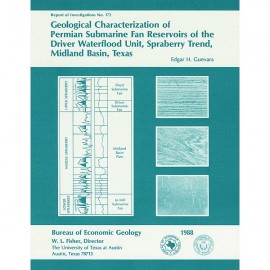Reports of Investigations
-
Books & Reports
- Reports of Investigations
- Guidebooks
- Udden Series
- Geological Circulars
- Down To Earth
- Atlases of Major Oil and Gas Reservoirs
- Texas Memorial Museum Publications
- Environmental Geologic Atlas of the Texas Coastal Zone
- Mineral Resource Circulars
- Other Reports
- Seminars and Workshops
- Handbooks
- Submerged Lands of Texas
- Symposia
- Annual Reports
- Open File Reports
-
Maps & Cross Sections
- Thematic Maps
- Miscellaneous Maps, Charts & Sections
- Geologic Atlas of Texas
- STATEMAP Project Maps
- Geologic Quadrangle Maps
- Cross Sections
- Highway Geology Map
- Energy and Mineral Resource Maps
- Shoreline Change and Other Posters
- Wilcox Group, East Texas, Geological / Hydrological Folios
- Bouguer Gravity Atlas of Texas
- River Basin Regional Studies
- Featured Maps
- Posters
- Teachers & the Public
-
Geological Society Publications
- Gulf Coast Association of Geological Societies
- Alabama Geological Society
- Austin Geological Society
- Corpus Christi Geological Society
- Houston Geological Society
- Lafayette Geological Society
- Mississippi Geological Society
- New Orleans Geological Society
- South Texas Geological Society
- GCS SEPM Publications
- Historic BEG & UT Series
Studies of Cenozoic Geology along Eastern Margin of Texas High Plains, Armstrong to Howard Counties
RI0032
Studies of Cenozoic Geology along Eastern Margin of Texas High Plains, Armstrong to Howard Counties, by J. C. Frye and A. B. Leonard. 62 p., 10 figs., 5 plates, 1957. Print Version.
A free, digital version of this publication can be found on: Texas ScholarWorks
RI0032. Studies of Cenozoic Geology along Eastern Margin of Texas High Plains, Armstrong to Howard Counties, by J. C. Frye and A. B. Leonard. 62 p., 10 figs., 5 plates, 1957. Print.
To purchase this publication as a downloadable PDF, please order RI0032D.
Excerpted from the Introduction
The eastern margin of the High Plains in central western Texas affords particularly good opportunity for study of late Cenozoic geology. The topography of the area is dominated by the southernmost segment of the late Tertiary mantle of fluvial sediments, isolated from the central and northern High Plains by the valley of the Canadian River. The eastern escarpment presents many exposures and the canyons that extend into the plains contain, in addition, a nearly complete sequence of Pleistocene terraces and deposits. The Canadian River, which crosses the Texas Panhandle north of the area under study, flows by way of the Arkansas River to the Mississippi. However, in the Plains to the south are the headwaters of drainage to Red River (which enters the Mississippi just above its delta) and of the Brazos and the Colorado rivers, each of which takes its independent course to the Gulf of Mexico. Therefore, the Pleistocene histories of adjacent High Plains canyons are indicative of independent drainage systems. These geographic relationships that place nearby streams under control of three different base level situations give special significance to late Cenozoic correlations in this region.
Field work on which this report is based has been discontinuously distributed over a decade. Several short periods were spent in the field from 1945 through 1949 when work was directed primarily toward correlation of Kansan age deposits with deposits in the northern Great Plains and with the glacial section of the Mid-West. This study was carried on largely by use of the distinctive petrography of the Pearlette volcanic ash bed and by fossil molluscan faunas (Frye, Swineford, and Leonard, 1948), but was accompanied by a reconnaissance of Pliocene and Pleistocene stratigraphy of the region. Field work directed specifically toward the present report consisted of several weeks in the fall of 1954 and summers of 1955 and 1956 under the auspices of the Bureau of EconomicGeology of The University of Texas.
… It is our purpose here to present the results of the regional integrated attack on the problems of correlation by use of fossil molluscan faunas, fossil seed floras, physiographic history, buried soils, lithology, and previously described volcanic ash petrography. From this approach there has emerged the basis for a framework of stratigraphic classification consistent with other parts of the Great Plains region. The data used are relatively widely spaced along the eastern margin of the Plains, and further detailed work is needed in this region to produce a desirable degree of refinement and certainty.
Keywords: Cenozoic, High Plains, Armstrong County, Howard County, Texas, Great Plains, faunas, fossils
Citation
Frye, J. C., and Leonard, A. B., 1957, Studies of Cenozoic Geology along Eastern Margin of Texas High Plains, Armstrong to Howard Counties: The University of Texas at Austin, Bureau of Economic Geology, Report of Investigations No. 32, 62 p.






